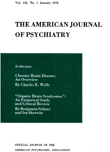PSYCHIATRIC OBSERVATIONS ON CONGENITAL AND ACQUIRED DEAFNESS : SYMBOLIC AND PERCEPTUAL PROCESSES IN DREAMS
Abstract
Twenty-six deaf college students were interviewed in the language of signs and manual alphabet to obtain information concerning the symbolic and perceptual processes experienced in their dreams. It was found that the dreams of the congenitally deaf were vivid, brilliantly colored, and reported as frequent in occurrence. Usually the language of signs was the means of communication in the dream, but in dreams in which affect was prominent, primitive signs were often utilized. The characteristic differences in the dreams of the deaf were most marked in the congenitally deaf, less marked in those with acquired deafness before age 5, and least marked in those with acquired deafness after age 5.
The relevance of these findings to superego formation, non-verbal communication processes, and recent observations in experimental sensory deprivation is discussed.
Access content
To read the fulltext, please use one of the options below to sign in or purchase access.- Personal login
- Institutional Login
- Sign in via OpenAthens
- Register for access
-
Please login/register if you wish to pair your device and check access availability.
Not a subscriber?
PsychiatryOnline subscription options offer access to the DSM-5 library, books, journals, CME, and patient resources. This all-in-one virtual library provides psychiatrists and mental health professionals with key resources for diagnosis, treatment, research, and professional development.
Need more help? PsychiatryOnline Customer Service may be reached by emailing [email protected] or by calling 800-368-5777 (in the U.S.) or 703-907-7322 (outside the U.S.).



